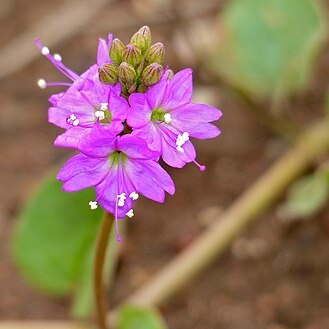Herbs perennial or subshrubs, ascending or procumbent, sometimes climbing, with lower branches ± woody, sometimes glandular. Leaves opposite, subequal, often fleshy, margin entire or undulate. Inflorescences terminal or axillary, pedunculate, umbels or verticils, sometimes grouped into panicles. Flowers bisexual. Perianth constricted beyond the ovary, limb funnelform, white, pink, or purple, 5-lobed. Stamens (2-)3(-6), often long exserted; filaments linear, unequal, connate at base. Ovary stipitate. Style linear, exserted; stigma peltate. Fruit clavate or obconic, 10-ribbed, with large, raised, wartlike sticky glands. Seed erect; embryo curved; cotyledons enclosing the scanty endosperm.
Subshrubs, diffuse or scandent, glabrous, pubescent or glandular-pilose. Leaves opposite, those at each node often of unequal size, often fleshy. Flowers inconspicuous or showy, in capitula, or umbels or in branched or unbranched verticels; bracteoles small, herbaceous or membranous, often glandular. Perianth tubular, the upper part caducous, trumpet-shaped, 5-lobed, white, pink or magenta-purple. Stamens 2–6, anthers suborbicular, exserted. Style slender, exserted; stigma capitate. Fruit indehiscent, obscurely 10-sulcate, studded with large, viscid, sessile or stipitate gland-warts. Seed 1, erect. See also Du Puy & Telford (1993: 103).
Perennial herbs or subshrubs with slender, climbing or trailing stems, often woody towards the base. Leaves opposite, subequal, mostly ovate-cordate, entire or sinuate, often fleshy, with conspicuous petioles. Inflorescences bisexual, in umbels or verticels, on moderately long pedicels, bracteate; perianth trumpet-shaped, 5-lobed; stamens 2–6, exserted; filaments united at the base. Ovary stipitate; style filiform, exserted; stigma capitate. Anthocarp cylindric-fusiform to clavate, rather obscurely 10-ribbed, with numerous, rather large, mucilaginous glands scattered over its surface; embryo hooked.
Perianth often with rhaphides clearly visible over surface, lower portion constricted above ovary with glands over surface often particularly around apex, greenish, persistent, upper portion petaloid, coloured, infundibuliform, shallowly lobed, sometimes with distinct basal tube, caducous after anthesis.
Anthocarps cylindrical, fusiform, clavate or turbinate, more or less 10-sulcate, with variously arranged, large, viscid, sessile or stipitate glands.
Leaves opposite in (sub) equal pairs, petiolate, often fleshy, usually entire or repand, rhaphides often visible on inferior surface in dried state.
Stamens 2–5 (6), exserted; filaments filiform, often unequal, connate into short sheath at the base; anthers dithecous.
Ovary usually ellipsoid, often stipitate, 1-ovulate; style filiform, exserted; stigma capitate.
Flowers small, fugacious, hermaphrodite, usually pedicellate; each pedicel bracteate.
Inflorescences umbellate, verticillate, irregularly branched or mixed, pedunculate.
Stems long, slender, erect, reclining or climbing, often much branched.
Perennial herbs or subshrubs.
Bracts caducous.

